

Principles of Management: Five Approaches to Organizational Design. Project Team Organization – Team Definition, Roles & Responsibilities, Organizational Chart. Mary LewinsonJuly 16, 201027,566 views Some basic information about project teams Proper project team organization is one of the key constraints to project success.
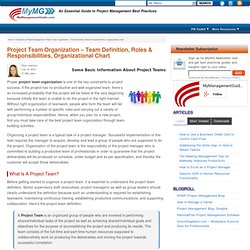
Differences Between Mechanistic And Organic Models Of Organizational Structure. Www.au.af.mil/au/awc/awcgate/army/guidterr/ch03.pdf. Charity and non profit organisation structure basics. The different ways of structuring a non profit organisation.
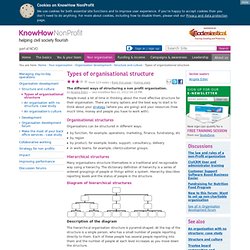
People invest a lot of time in thinking about the most effective structure for their organisation. There are many options and the best way to start is to think about your strategy (where you are going) and your resources (how much time, money and people you have to work with). Organisational structures Organisations can be structured in different ways: by function, for example, operations, marketing, finance, fundraising, etcby regionby product, for example, books, support, consultancy, deliveryin work teams, for example, client/customer groups.
Hierarchical structures Many organisations structure themselves in a traditional and recognisable way using a hierarchy. Diagram of hierarchical structures Description of the diagram The hierarchical organisation structure is pyramid-shaped. Advantages of hierarchical structures A hierarchical structure uses clear reporting lines. Organizational Structures. Introduction Any operating organization should have its own structure in order to operate efficiently.
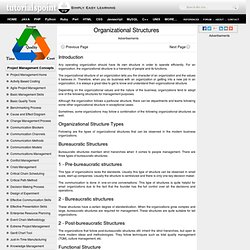
For an organization, the organizational structure is a hierarchy of people and its functions. The organizational structure of an organization tells you the character of an organization and the values it believes in. Therefore, when you do business with an organization or getting into a new job in an organization, it is always a great idea to get to know and understand their organizational structure. Depending on the organizational values and the nature of the business, organizations tend to adopt one of the following structures for management purposes. Although the organization follows a particular structure, there can be departments and teams following some other organizational structure in exceptional cases.
Sometimes, some organizations may follow a combination of the following organizational structures as well. Organizational structure. An organizational structure defines how activities such as task allocation, coordination and supervision are directed towards the achievement of organizational aims.[1] It can also be considered as the viewing glass or perspective through which individuals see their organization and its environment.[2] Organizations are a variant of clustered entities.
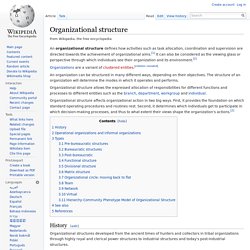
[citation needed] An organization can be structured in many different ways, depending on their objectives. The structure of an organization will determine the modes in which it operates and performs. Organizational structure affects organizational action in two big ways. History[edit] Organizational structures developed from the ancient times of hunters and collectors in tribal organizations through highly royal and clerical power structures to industrial structures and today's post-industrial structures. Organisational Structures/Organ. INTRODUCTION TO ORGANISATIONAL STRUCTURES Introduction Organisations are structured in a variety of ways, dependant on their objectives and culture.

The structure of an organisation will determine the manner in which it operates and it’s performance. Structure allows the responsibilities for different functions and processes to be clearly allocated to different departments and employees. Organisation Structure and Business Success The wrong organisation structure will hinder the success of the business. Organisational structures should aim to maximise the efficiency and success of the Organisation.
An effective organisational structure will facilitate working relationships between various sections of the organisation. The most common organisation structures are: · Tall · Flat · Hierarchical · Centralised and decentralised Click on the links above to learn about each of the structures. Organisational Structures. This lesson is designed to be used in the classroom or as a homework task to support the teaching and learning of Organisational Structures in BTEC Business.
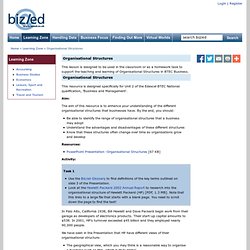
This resource is designed specifically for Unit 2 of the Edexcel BTEC National qualification, 'Business and Management'. Aim: The aim of this resource is to enhance your understanding of the different organisational structures that businesses have. By the end, you should: Be able to identify the range of organisational structures that a business may adoptUnderstand the advantages and disadvantages of these different structuresKnow that these structures often change over time as organisations grow and develop Resources: PowerPoint Presentation -Organisational Structures [67 KB] Activity: